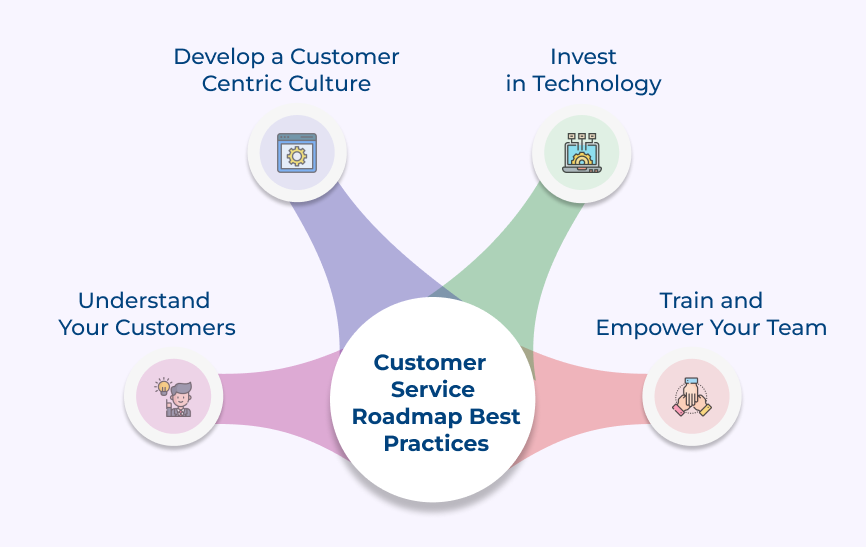1. Define Your Customer Service Vision & Objectives
A customer service vision is a statement that defines the organization’s customer service goals. It should be simple, memorable and inspire employees to deliver excellent customer service. Customer service objectives are specific, measurable and time-bound targets that the business owner sets to achieve its vision.
Companies must be clear on what they want to achieve in terms of customer service. It may be to provide timely and efficient service delivery, handle customer inquiries effectively, or exceed customer expectations. Whatever the vision or objective may be, it should be centered on the customer and the focus should be on delivering the best possible experience to them.
Best practices:
- Define clear, specific customer service goals that align with the organization’s overall mission and values.
- Implement metrics and tracking systems to measure progress toward the set goals.
- Regularly communicate and reinforce the importance of delivering exceptional customer service to all employees throughout the organization.
2. Map Your Customer Journey and Identify Pain Points at Each Stage
The customer journey is the path that a customer takes from the point of first contact with the organization to the point of purchase or resolution of an issue. Mapping the customer journey helps the organization to understand the customer’s experience and identify areas where the experience can be improved.
The organization needs to identify the pain points that customers encounter at each stage of the journey. Pain points are the moments when the customer feels frustrated, confused, or unhappy with the service they receive. Once the pain points are identified, companies should develop solutions aimed at alleviating the customer’s frustration and improving their experience.
Best practices:
- Map your customer journey by identifying all touchpoints and interactions customers have with your company to better understand their experience.
- Use data to identify pain points at each stage of the customer journey to prioritize areas for improvement and focus resources.
- Creating a powerful customer service roadmap means consistently monitoring and updating your customer journey map to stay responsive to changing customer needs and expectations.
3. Prioritize Support Gaps based on Impact and Feasibility
The support gaps are areas where your customer service is lacking and your customers are not receiving the support they need. Start by analyzing customer feedback and support interactions to identify these gaps. Prioritize them based on their potential impact on your customer’s experience and the feasibility of addressing them.
Each business should understand that they cannot address all the support gaps at once. So, they need to focus on the ones that have the most significant impact on the customers. Prioritizing the support gaps based on their impact and feasibility one can easily create an action plan to address them systematically.
Best practices:
- Prioritize support gaps based on their potential impact on customers and the feasibility of addressing them in a timely and effective manner.
- Balance short-term and long-term goals in developing a product roadmap that will drive customer satisfaction.
- Continuously adjust the roadmap based on evolving customer needs, feedback and market conditions.
4. Develop Customer Service Standards and Communication Guidelines
Once you have identified the support gaps and prioritized them, the next step is to develop customer service standards and communication guidelines. The standards and guidelines will help you ensure that you consistently provide high-quality support experiences.
Start by defining your customer service standards. The standards should cover factors such as response time, issue resolution and overall customer experience. It’s vital to ensure the standards align with your customers’ expectations. Communication guidelines should cover aspects such as tone, language and communication channels.
Best practices:
- Conduct a thorough needs assessment to identify the specific customer service standards and communication guidelines required for your business.
- Establish measurable targets for customer service performance and communicate these expectations to all team members.
- Regularly evaluate your customer service standards to ensure they remain current, relevant and effective.
5. Focus on Delivering Seamless Omnichannel Support
Organizations that can deliver consistent, high-quality customer service across multiple channels are more likely to enjoy customer loyalty and long-term success. Businesses that use omnichannel strategies see 91% greater year-over-year rates of client retention than those that don’t.
Companies can build an effective customer service roadmap by identifying all the channels their customers currently use for their reach out. Develop processes and policies that enable your customer service agents to deliver a consistent level of high-quality support across all these channels. Providing your team with the right training/tools such as an omnichannel customer service platform and implementing automated solutions can help you to optimize your omnichannel support strategy.
Best practices:
- Utilize data analysis to understand which channels your customers prefer and ensure that they all work together seamlessly to improve their overall experience.
- Train your employees thoroughly on how to use all available channels effectively, and encourage them to prioritize the customer’s needs over the channel itself.
- Regularly monitor feedback from customers to identify pain points and areas for improvement to continually optimize your support roadmap.
6. Solicit Feedback and Measure KPIs to Identify Improvement Areas
Irrespective of the industry, a business must know what customers want and expect from them to deliver top-notch customer service. The best way to gain customer feedback is to solicit it directly from them by sending out surveys, conducting focus groups or setting up feedback forums on your website or social media channels.
Identify the critical key performance indicators (KPIs) that will help monitor and measure customer satisfaction. They include metrics such as first response time, customer resolution time and customer satisfaction scores. The metrics help to identify areas for improvement to ensure that your customer service continually improves and meets or exceeds customer expectations.
Best practices:
- Use key performance indicators (KPIs) to measure the success of your customer service efforts and identify areas that need improvement.
- Analyze the KPI data to create a roadmap for enhancing your customer service strategy and delivering a better overall experience for customers.
- Continuously adjust your customer service roadmap to adapt to changing customer needs and ensure ongoing success.
Challenges to Implement Customer Care Roadmap (& How to Avoid Them)
Following are the key challenges businesses can face during the implementation of a customer care roadmap along with some actionable strategies to avoid them.
Lack of Management & Employee Buy-in
One of the biggest challenges businesses face is getting management and employees on board with the customer service roadmap. The success of a customer roadmap depends on the shared belief among employees and management that customer service is crucial to business success. Without the buy-in, businesses experience apathy and inaction, which hinders the implementation of the roadmap.
Leaders must communicate the goals and strategies of the customer roadmap, explain how employees’ roles contribute to the outcome and lead by example in practicing excellent customer service.
Inadequate Measurement and Evaluation Metrics
Another challenge to implementing a customer care roadmap is the lack of appropriate metrics to measure and evaluate success. Product managers must identify which metrics are crucial for measuring customer satisfaction, employee performance and overall business success.
Many businesses fail to set up appropriate metrics, leading to inaccurate and incomplete evaluations of their customer service roadmap’s progress. Businesses must be open to making changes to the roadmap if necessary based on the feedback obtained through the metrics.
Irregular Communication and Alignment among Stakeholders
One common challenge businesses often experience is insufficient communication and alignment among stakeholders. Often, customer service intersects with several departments, and a lack of communication among departments can cause multiple issues.
Businesses must establish open lines of communication and alignment among all stakeholders with regular meetings among departments. It ensures that everyone understands their role in the customer service roadmap, and bring in stakeholders at different stages to ensure alignment.
Insufficient Resources and Budget Constraints
Another challenge that many businesses face when implementing customer service roadmaps is limited resources, including time and budget constraints. Businesses may lack the time or money necessary to implement the roadmap thoroughly.
Companies should always start small and prioritize the most important components of the roadmap. Communicate with department heads to ensure that sufficient resources are allocated and ensure that the roadmap is realistic, given the current constraints.
Difficulty in Prioritizing Areas of Improvement
Plenty of customer service channels are now available in the market. It can be overwhelming to figure out which channels need the most attention.
Businesses should start by reviewing customer feedback and identifying the areas of customer service that need the most improvement. Once the areas of improvement have been identified, it is important to prioritize them based on their impact on customer satisfaction.
Customer Service Roadmap Best practices
If you’re ready to transform your service delivery, here are key best practices that will serve as a roadmap to deliver customer service excellence.

